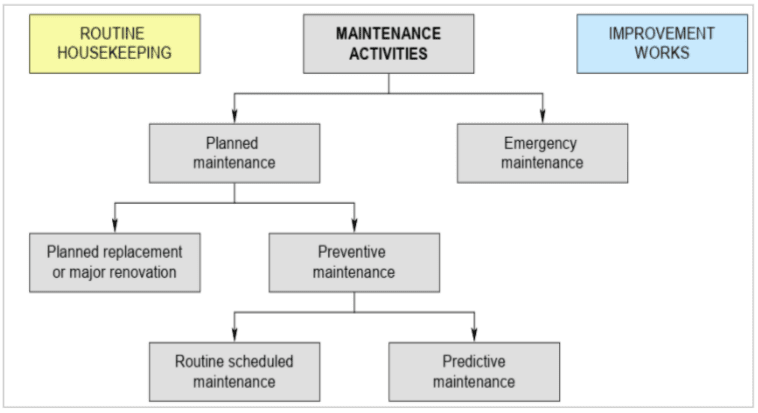Maintenance of the Warehouse
- Maintenance of buildings, effectively carried out, ensures that the building and its contents are protected from damage and loss.
- Building maintenance is the totality of all actions that keep a building functioning effectively.
- Maintenance helps protect the financial assets tied up in the building; it is not the same as improvement.
- The purpose of improvement is to alter and/or extend the building in ways which respond to changing user requirements and this may increase its value.
Types of maintenance and related activities


Programmed maintenance is sub-divided into the following categories:
- Planned replacement ensures that building elements such as windows and roof finishes are replaced when they reach the end of their designated service life. Planned replacement minimizes the need for emergency maintenance and prevents the consequential damage which will occur if the element is left to fail.
- Preventive maintenance ensures that building elements are well maintained and that they do indeed achieve their designated service life. This can be achieved by routine scheduled maintenance – for example regular redecoration of windows or regular lubrication of mechanical components – or by predictive maintenance – dealing with a minor problem identified during a routine inspection, such as vibration in an air-conditioning unit, before it develops into a major problem and becomes an emergency.
Learning Activities
In not more than 1000 words, compare and contrast the u-shaped lay out and the through flow lay out. Be certain to include the inherent benefits and challenges of each layout in your discussion.
Assignment
The major problem addressed by the warehouse layout strategy is?
- Minimize the difficulties caused by material flow varying with each product
- Addressing trade-offs between space and material handling
- The movement of material to the limited storage areas around the site
- Requiring frequent contact close to one another
Which of the following is not a type of warehouse layout?
- U-shaped
- I-Shaped
- Corner Flow
- H-Shaped
